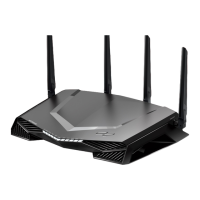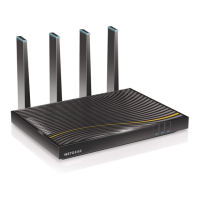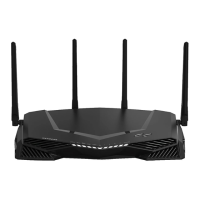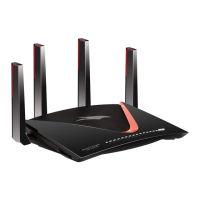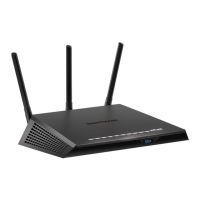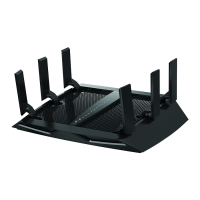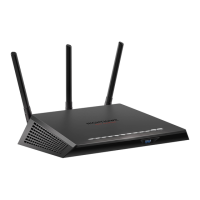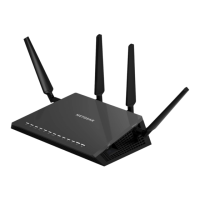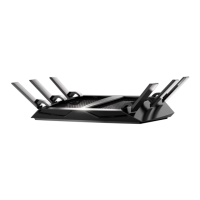Do you have a question about the NETGEAR XS512EM and is the answer not in the manual?
Details the physical components and indicators on the front of the switch for identification and status monitoring.
Explains the meaning of each LED indicator on the switch, providing insight into operational status and link activity.
Describes the SFP+ slots for connecting fiber or copper transceivers for network connectivity.
Guides users through the initial physical setup, network connection, and powering on the switch.
Outlines various methods for locating the switch on the network and accessing its management interface.
Details the procedure for changing the default administrator password to enhance network security.
Explains how to group switch ports into virtual networks using port-based VLANs for traffic isolation.
Provides instructions for configuring IEEE 802.1Q VLANs, enabling network segmentation with VLAN IDs.
Details how to configure QoS based on 802.1p or DSCP tags to prioritize network traffic.
Explains how to assign priority levels to traffic on a per-port basis to manage network performance.
Guides users on how to configure static IP addresses, subnet masks, and gateway settings for the switch.
Covers the setup of link aggregation groups (LAGs) for increased bandwidth and fault tolerance.
Details how to configure loop prevention to detect and block network loops, preventing broadcast storms.
Provides instructions for downloading and installing the latest firmware to ensure optimal performance and security.
Explains the process of resetting the switch to its original factory default configuration.
Describes how to use the cable diagnostic feature to test network cable health and identify faults.
Provides steps to resolve subnet conflicts that may prevent access to the switch's management interface.
Offers a chart listing common hardware symptoms, their possible causes, and suggested solutions.
Lists the default configuration settings of the switch when reset to factory defaults.
Presents key technical specifications of the switch, including IEEE standards, network interfaces, and cable requirements.
Details the physical components and indicators on the front of the switch for identification and status monitoring.
Explains the meaning of each LED indicator on the switch, providing insight into operational status and link activity.
Describes the SFP+ slots for connecting fiber or copper transceivers for network connectivity.
Guides users through the initial physical setup, network connection, and powering on the switch.
Outlines various methods for locating the switch on the network and accessing its management interface.
Details the procedure for changing the default administrator password to enhance network security.
Explains how to group switch ports into virtual networks using port-based VLANs for traffic isolation.
Provides instructions for configuring IEEE 802.1Q VLANs, enabling network segmentation with VLAN IDs.
Details how to configure QoS based on 802.1p or DSCP tags to prioritize network traffic.
Explains how to assign priority levels to traffic on a per-port basis to manage network performance.
Guides users on how to configure static IP addresses, subnet masks, and gateway settings for the switch.
Covers the setup of link aggregation groups (LAGs) for increased bandwidth and fault tolerance.
Details how to configure loop prevention to detect and block network loops, preventing broadcast storms.
Provides instructions for downloading and installing the latest firmware to ensure optimal performance and security.
Explains the process of resetting the switch to its original factory default configuration.
Describes how to use the cable diagnostic feature to test network cable health and identify faults.
Provides steps to resolve subnet conflicts that may prevent access to the switch's management interface.
Offers a chart listing common hardware symptoms, their possible causes, and suggested solutions.
Lists the default configuration settings of the switch when reset to factory defaults.
Presents key technical specifications of the switch, including IEEE standards, network interfaces, and cable requirements.
| Switch type | Managed |
|---|---|
| Switch layer | L2 |
| Quality of Service (QoS) support | Yes |
| Stackable | - |
| Form factor | 1U |
| Certification | 47 CFR FCC, ICES-003:2016, ANSI C63.4:2014, EN55032:2012+AC:2013, EN 55024:2010, EN 61000-3-2:2014, EN 6100-3-3:2013, AS/NZS CISPR 32:2013, VCCI-CISPR32:2016, CNS 13438, IEC 60950-1:2005(ed.2) + A1:2009 + A2:2013, UL 60950-1, EN 60950-1: 2006 + A11:2009 + A1:2010 + A12:2011 + A2:2013, IEC 60950-1:2005 (ed.2)+A1:2009+A2:2013, AS/NZS 60950.1:2015 CNS14336-1 |
| Product color | Blue, Grey |
| Number of fans | 2 fan(s) |
| Power connector | DC-in jack |
| SFP+ module slots quantity | 2 |
| Basic switching RJ-45 Ethernet ports type | 10G Ethernet (100/1000/10000) |
| Basic switching RJ-45 Ethernet ports quantity | 12 |
| Jumbo frames | 9000 |
| MAC address table | 32000 entries |
| Packet buffer memory | 3 MB |
| Mean time between failures (MTBF) | 1113477 h |
| Number of VLANs | 64 |
| Networking standards | IEEE 802.1Q, IEEE 802.1p, IEEE 802.3, IEEE 802.3ab, IEEE 802.3ae, IEEE 802.3an, IEEE 802.3az, IEEE 802.3bz, IEEE 802.3u, IEEE 802.3x, IEEE 802.3z |
| Virtual LAN features | Port-based VLAN |
| Input current | 2 A |
| AC input voltage | 100 - 240 V |
| AC input frequency | 50 - 60 Hz |
| DHCP features | DHCP client |
| Sustainability certificates | ENERGY STAR |
| Heat dissipation | 261.38 BTU/h |
| Storage temperature (T-T) | -20 - 70 °C |
| Operating temperature (T-T) | 0 - 50 °C |
| Storage relative humidity (H-H) | 0 - 95 % |
| Operating relative humidity (H-H) | 0 - 90 % |
| Harmonized System (HS) code | 85176990 |
| Depth | 204 mm |
|---|---|
| Width | 328 mm |
| Height | 43 mm |
| Weight | 2510 g |


